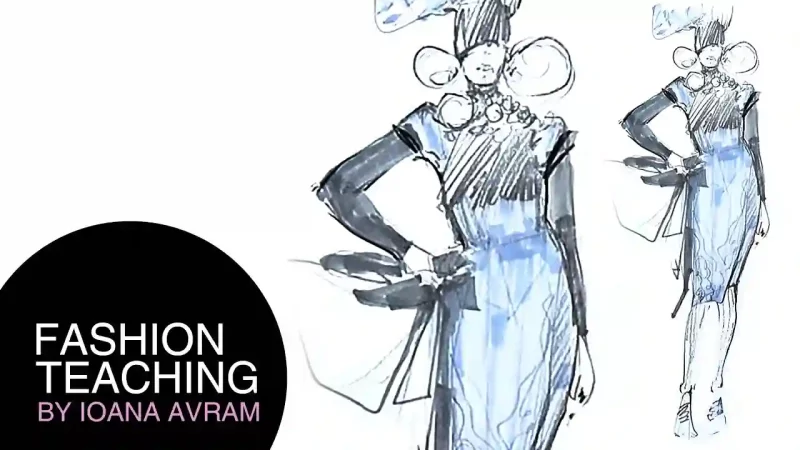Fashion sketching is the backbone of the fashion industry, where ideas are born, refined, and transformed into wearable art. In the realm of ready-to-wear fashion, the goal is to create stylish yet functional designs that cater to the everyday needs of a wide range of consumers. In this article, we will explore the world of fashion sketching for ready-to-wear, focusing on the art of crafting stylish and practical designs that resonate with today’s fashion-savvy consumers.
1. Define Your Target Audience:
Before you put pencil to paper, it’s crucial to have a clear understanding of your target audience. Are you designing for young professionals, busy parents, or trendsetting teenagers? Knowing your audience’s preferences and lifestyle helps you create designs that are not only stylish but also functional.
2. Embrace Versatility:
Ready-to-wear fashion is all about versatility. Sketch designs that can be dressed up or down, allowing wearers to transition seamlessly from day to night. Versatile pieces are not only practical but also highly sought after by consumers.
3. Start with a Strong Silhouette:
The foundation of any fashion sketch is a well-defined silhouette. For ready-to-wear, opt for classic and flattering shapes that suit a variety of body types. Sketch basic outlines that form the basis for your designs.
4. Focus on Comfort:
Functionality in ready-to-wear fashion often translates to comfort. Sketch designs that prioritize ease of movement and comfort without compromising on style. Think about fabrics that breathe and silhouettes that flatter the wearer.
5. Pay Attention to Fabric Selection:
Fabric plays a vital role in ready-to-wear designs. Sketch with specific fabrics in mind, considering their drape, texture, and weight. The choice of fabric can make or break the functionality of a design.
6. Incorporate Practical Details:
Functional details can set ready-to-wear designs apart. Consider adding pockets, zippers, adjustable straps, and other practical elements that enhance the usability of your sketches. These details resonate with consumers looking for both style and functionality.
7. Explore Color Palettes:
Color is a powerful tool in fashion sketching. Experiment with color palettes that are not only visually appealing but also versatile. Earthy tones, neutrals, and classic hues often work well for ready-to-wear fashion, as they can easily mix and match with other pieces.
8. Mix and Match:
Sketching complete outfits allows you to demonstrate how your designs can be mixed and matched. Show how a blouse can be paired with different bottoms or how accessories can transform a look. Mixing and matching are key to creating a functional wardrobe.
9. Sketch Day-to-Night Transitions:
Ready-to-wear fashion often needs to transition seamlessly from day to night. Sketch designs that can be accessorized or layered to adapt to different occasions, adding functionality and versatility to your creations.
10. Experiment with Layering:
Layering is a hallmark of ready-to-wear fashion. Sketch outfits that incorporate layering, such as cardigans, blazers, or lightweight jackets. Layered looks offer both style and adaptability for various weather conditions.
11. Consider Practical Footwear:
Footwear is an essential part of ready-to-wear fashion. When sketching outfits, don’t forget to include footwear designs that complement the overall look and are suitable for everyday wear.
12. Sketch Everyday Accessories:
Accessories are the finishing touch to any outfit. Sketch practical accessories like handbags, belts, scarves, and hats that enhance the functionality and style of your designs.
13. Think About Sustainability:
Sustainability is a growing concern in the fashion industry. Sketch designs that incorporate sustainable materials, eco-friendly production methods, and longevity in their functionality. Sustainable fashion is not only trendy but also responsible.
14. Sketch for All Seasons:
Ready-to-wear fashion is meant to cater to different seasons and climates. Create sketches that address the needs of consumers throughout the year, from summer dresses to winter coats.
15. Be Mindful of Trends:
While functionality is key in ready-to-wear, staying updated on fashion trends is essential. Incorporate trendy elements into your sketches, but be mindful not to sacrifice functionality for fleeting fashion fads.
16. Study Successful Brands:
Look to successful ready-to-wear brands for inspiration. Study their designs and how they balance style and functionality. Analyze what makes their designs resonate with consumers.
17. Seek Feedback and Collaboration:
Share your ready-to-wear sketches with peers, mentors, or online communities. Constructive feedback can help you refine your skills and understand the needs of consumers better. Collaborating with others can provide fresh perspectives on functional design.
18. Be Patient and Persistent:
Becoming proficient in fashion sketching for ready-to-wear takes time and dedication. Be patient with yourself and keep practicing regularly. With each sketch, you’ll refine your ability to balance style and functionality.
19. Network in the Fashion Industry:
Networking is valuable in the fashion industry. Attend fashion events, connect with established designers, and build relationships within the fashion world. Networking can lead to opportunities and collaborations that enhance your understanding of ready-to-wear fashion.
20. Infuse Your Personality:
While functionality is essential, don’t forget to infuse your personality and unique style into your sketches. Your individual flair can set your ready-to-wear designs apart and make them stand out in a competitive market.
In conclusion, fashion sketching for ready-to-wear is a dynamic and creative process that demands a delicate balance between style and functionality. As you immerse yourself in this world of practical yet stylish designs and explore these ideas, you’ll find your skills evolving and your ready-to-wear sketches resonating with the fashion-savvy consumers of today. Let your sketches be a testament to your ability to create wearable art that enriches the lives of those who wear it, bridging the gap between style and functionality in the world of fashion.

